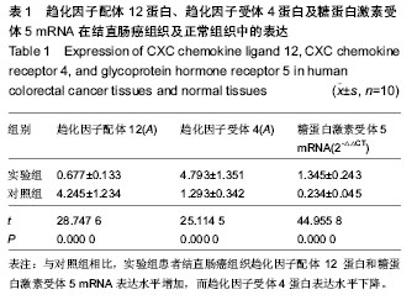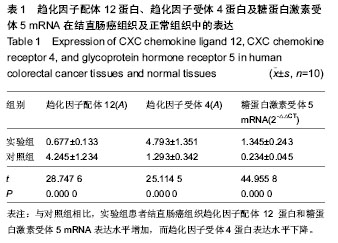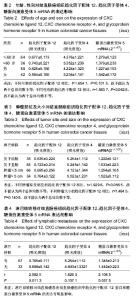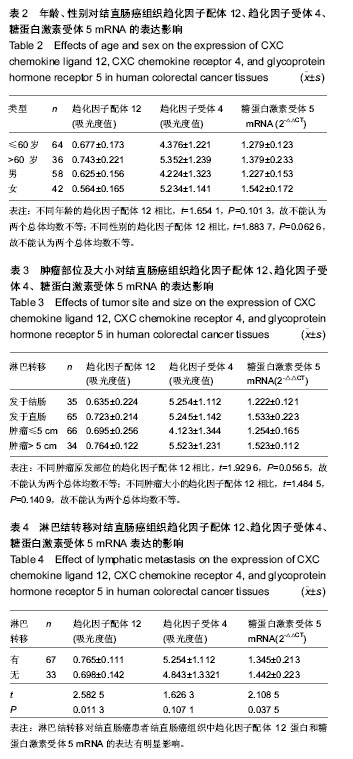Chinese Journal of Tissue Engineering Research ›› 2014, Vol. 18 ›› Issue (19): 3105-3110.doi: 10.3969/j.issn.2095-4344.2014.19.025
Previous Articles Next Articles
Biological axis of CXC chemokine ligand and expression of stem cell markers in human colorectal cancer tissues as well as their relationship with clinical and pathological characteristics
Huang Zhe
- Department of Colorectal Surgery, Liaoning Cancer Hospital & Institute, Shenyang 110042, Liaoning Province, China
-
Revised:2014-04-08Online:2014-05-07Published:2014-05-07 -
Contact:Huang Zhe, M.D., Associate chief physician, Department of Colorectal Surgery, Liaoning Cancer Hospital & Institute, Shenyang 110042, Liaoning Province, China -
About author:Huang Zhe, M.D., Associate chief physician, Department of Colorectal Surgery, Liaoning Cancer Hospital & Institute, Shenyang 110042, Liaoning Province, China
CLC Number:
Cite this article
Huang Zhe. Biological axis of CXC chemokine ligand and expression of stem cell markers in human colorectal cancer tissues as well as their relationship with clinical and pathological characteristics[J]. Chinese Journal of Tissue Engineering Research, 2014, 18(19): 3105-3110.
share this article

2.1 参与者数量分析及临床信息 所有参与者均进入结果分析,且2组参与者的年龄、性别等一般资料比较差异无显著性意义(P > 0.05),具有可比性。 2.2 趋化因子配体12在结直肠癌组织中的表达 虽然趋化因子配体12在结直肠癌组织和正常组织中均有出现,但与正常组织相比,结直肠癌组织中趋化因子配体12表达水平较低(P < 0.05,表1)。 2.3 趋化因子受体4在结直肠癌组织及匹配正常组织中的表达 与对照组相比,结直肠癌患者结直肠组织中趋化因子受体4表达水平明显上升(P < 0.05,表1)。 2.4 糖蛋白激素受体5 mRNA在结直肠癌组织及匹配正常组织中的表达 与对照组相比,结直肠癌患者结直肠组织中干细胞标志物糖蛋白激素受体5 mRNA表达显著上升(P < 0.05,表1)。"


2.5 年龄和性别对结直肠癌组织中趋化因子配体12、趋化因子受体4及干细胞标志物糖蛋白激素受体5 mRNA表达的影响 对60岁以上和以下患者进行观察,其结直肠癌组织趋化因子配体12、趋化因子受体4及糖蛋白激素受体5 mRNA的表达差异无显著意义(P > 0.05);且不同性别患者结直肠癌组织趋化因子配体12、趋化因子受体4及糖蛋白激素受体5 mRNA的表达差异无显著意义(P > 0.05,表2)。 2.6 肿瘤原发部位、肿瘤大小对结直肠癌组织趋化因子配体12、趋化因子受体4、干细胞标志物糖蛋白激素受体5 mRNA表达的影响 经过对比观察,肿瘤原发部位无论是在直肠还是结肠,都对结直肠癌组织趋化因子配体12、趋化因子受体4、糖蛋白激素受体5 mRNA表达的差异无显著意义(P > 0.05);肿瘤大小对结直肠癌组织趋化因子配体12、趋化因子受体4、糖蛋白激素受体5 mRNA表达的差异也无显著意义(P > 0.05,表3)。2.7 淋巴结转移对结直肠癌组织趋化因子配体12、趋化因子受体4及干细胞标志物糖蛋白激素受体5 mRNA表达的影响 经过对比发现,有淋巴结转移的结直肠癌患者结直肠癌组织中趋化因子配体12、糖蛋白激素受体5 mRNA的表达都明显增高(P < 0.05),而趋化因子受体4的差异无显著性意义(P > 0.05,表4)。"

| [1] Ellidag HY, Bulbuller N, Eren E, et al. Ischemia-modified albumin: could it be a new oxidative stress biomarker for colorectal carcinoma? Gut Liver. 2013;7(6):675-680. [2] Hatakeyama T, Nakanishi M, Murayama Y, et al. Laparoscopic resection for colorectal cancer improves short-term outcomes in very elderly colorectal cancer patients. Surg Laparosc Endosc Percutan Tech. 2013; 23(6):532-535. [3] 卫生部医政司.结直肠癌诊疗规范(2010年版)[J].中国医学前沿杂志(电子版),2011,3(6):130-146. [4] Tanksley JP, Chen X, Coffey RJ. NEDD4L is downregulated in colorectal cancer and inhibits canonical WNT signaling. PLoS One. 2013;8(11):e81514. [5] Dennis DL, Waring JL, Payeur N, et al. Making lifestyle changes after colorectal cancer: insights for program development. Curr Oncol. 2013;20(6):e493-511. [6] Folse HJ, Green LE, Kress A, et al. Cost-effectiveness of a genetic test for breast cancer risk. Cancer Prev Res (Phila). 2013;6(12):1328-1336. [7] Arteaga González I, Martín Malagón A, Garcia SG, et al. Single-incision laparoscopic surgery for colon and rectal cancer: an initial experience with the technique. Surg Laparosc Endosc Percutan Tech. 2013;23(6):494-497. [8] Glenister R, McDaniel K, Francis H, et al. Therapeutic actions of melatonin on gastrointestinal cancer development and progression. Transl Gastrointest Cancer. 2013;2(1). [9] Park JJ, Lee M. Increasing the α 2, 6 sialylation of glycoproteins may contribute to metastatic spread and therapeutic resistance in colorectal cancer. Gut Liver. 2013; 7(6):629-641. [10] Endo S, Takehara Y, Tanaka J, et al. Complete laparoscopic surgery for early colorectal cancer after endoscopic resection. Asian J Endosc Surg. 2013;6(4):338-341. [11] Lee H, Flaherty P, Ji HP. Systematic genomic identification of colorectal cancer genes delineating advanced from early clinical stage and metastasis. BMC Med Genomics. 2013;6: 54. [12] Samardzi? S, Mihaljevi? S, Dmitrovi? B, et al. First six years of implementing colorectal cancer screening in the Osijek-Baranja County, Croatia--can we do better? Coll Antropol. 2013;37(3):913-918. [13] 崔同建,陈义乾,戴永美等.大肠癌中医证型与ERCC1基因多态性的相关研究[J].中国中西医结合杂志,2012,32(5):628-632. [14] Fu JF, Huang YQ, Yang J, et al. Clinical characteristics and prognosis of young patients with colorectal cancer in Eastern China. World J Gastroenterol. 2013;19(44):8078-8084. [15] Marques I, Araújo A, de Mello RA. Anti-angiogenic therapies for metastatic colorectal cancer: current and future perspectives. World J Gastroenterol. 2013;19(44):7955-7971. [16] 谷学军,秦望森,许金玲.血清CA125联合CA19-9及CEA检测应用于大肠癌诊断的临床价值[J].中国实验诊断学,2012,16(6): 1047-1049. [17] He Z, Subramaniam D, Zhang Z, et al. Honokiol as a Radiosensitizing Agent for Colorectal cancers. Curr Colorectal Cancer Rep. 2013;9(4). [18] Andrews L. Dietary flavonoids for the prevention of colorectal cancer. Clin J Oncol Nurs. 2013;17(6):671-672. [19] Osumi H, Matsusaka S, Shinozaki E, et al. Acquired drug resistance conferred by a KRAS gene mutation following the administration of cetuximab: a case report. BMC Res Notes. 2013;6:508. [20] Luckmann R, Costanza ME, Rosal M, et al. Referring patients for telephone counseling to promote colorectal cancer screening. Am J Manag Care. 2013;19(9):702-708. [21] Madhavan S, Gauba R, Song L, et al. Platform for Personalized Oncology: Integrative analyses reveal novel molecular signatures associated with colorectal cancer relapse. AMIA Summits Transl Sci Proc. 2013;2013:118. [22] Wagholikar K, Sohn S, Wu S, et al. Workflow-based data reconciliation for clinical decision support: case of colorectal cancer screening and surveillance. AMIA Summits Transl Sci Proc. 2013;2013:269-273. [23] Arteaga González I, Martín Malagón A, Garcia SG, et al. Single-incision laparoscopic surgery for colon and rectal cancer: an initial experience with the technique. Surg Laparosc Endosc Percutan Tech. 2013;23(6):494-497. [24] Transanal endoscopic operations in the complex treatment of the complicated colorectal cancer. Khirurgiia (Mosk). 2013; (11):67-68. [25] Kakugawa Y, Saito Y, Matsuda T, et al. Colorectal laterally spreading tumors by computed tomographic colonography. Int J Mol Sci. 2013;14(12):23629-23638. [26] Fournier A, Hill C. Drugs and cancer risk: the example of THM. Rev Prat. 2013;63(8):1117-1121. [27] 王晓戎,袁孝兵,储慧琴,等.因子分析和聚类分析联合应用在大肠癌证候分布中的研究[J].时珍国医国药,2012,23(5): 1194-1195. [28] Gill P, Rafferty H, Munday D, et al. Proximal colon cancer and serrated adenomas - hunting the missing 10%. Clin Med. 2013; 13(6):557-561. [29] Min MR, Chowdhury S, Qi Y, et al. An integrated approach to blood-based cancer diagnosis and biomarker discovery. Pac Symp Biocomput. 2014:87-98. [30] McLaughlan J, Ingram N, Smith PR, et al. Increasing the sonoporation efficiency of targeted polydisperse microbubble populations using chirp excitation. IEEE Trans Ultrason Ferroelectr Freq Control. 2013;60(12):2511-2520. [31] Halabi WJ, Jafari MD, Nguyen VQ, et al. Blood transfusions in colorectal cancer surgery: incidence, outcomes, and predictive factors: an American College of Surgeons National Surgical Quality Improvement Program analysis. Am J Surg. 2013;206(6):1024-1033. [32] Shukla RK. Recent advances in oral anticancer agents for colon cancer. Future Oncol. 2013;9(12):1893-1908. [33] Hudson AG, Mertz KJ, Jubelirer SJ, et al. Cancer incidence in elderly West Virginians. W V Med J. 2013;109(5):8-12. [34] Pericleous M, Mandair D, Caplin ME. Diet and supplements and their impact on colorectal cancer. J Gastrointest Oncol. 2013;4(4):409-423. [35] 黄颖烽,魏亚明,李秋娴,等.大肠癌患者外周血细胞CD133的表达[J].中国组织工程研究与临床康复,2011,15(40):7597-7600. [36] Duraj FF, Cashin PH. Cytoreductive surgery and intraperitoneal chemotherapy for colorectal peritoneal and hepatic metastases: a case-control study. J Gastrointest Oncol. 2013;4(4):388-396. [37] Shafaei S, Sharbatdaran M, Kamrani G, et al. The association between CD166 detection rate and clinicopathologic parameters of patients with colorectal cancer. Caspian J Intern Med. 2013;4(4):768-772. [38] Shintani M, Sangawa A, Yamao N, et al. Immunohistochemical expression of nuclear and cytoplasmic survivin in gastrointestinal carcinoma. Int J Clin Exp Pathol. 2013;6(12):2919-2927. [39] Patel GS, Karapetis CS. Personalized treatment for advanced colorectal cancer: KRAS and beyond. Cancer Manag Res. 2013;5:387-400. [40] Dhir M, Lyden ER, Smith LM, et al. Influence of margins on disease free survival following hepatic resection for colorectal metastasis: a meta-analysis. Indian J Surg Oncol. 2012; 3(4):321-329. [41] Bangaru H, Veitla RM, Pigilam M, et al. Comparative Study between Staplers and Conventional(Hand-Sewn) Anastomosis in Gastrointestinal Surgery. Indian J Surg. 2012;74(6):462-467. [42] 秦海春,刘俊,杜廷义,等.CEA蛋白、CEA mRNA在大肠癌诊断中的应用价值[J].现代预防医学,2012,39(9):2255-2256. [43] Fathallah RM, Dajani R. Comparison of population based cancer incidence rates among Circassians, Chechans and Arabs in Jordan (1996-2005). Asian Pac J Cancer Prev. 2013;14(10):6035-6040. [44] Rasool S, Kadla SA, Khan T, et al. Association of a VDR gene polymorphism with risk of colorectal cancer in Kashmir. Asian Pac J Cancer Prev. 2013;14(10):5833-5837. [45] Pandurangan AK, Esa NM. Dietary non-nutritive factors in targeting of regulatory molecules in colorectal cancer: an update. Asian Pac J Cancer Prev. 2013;14(10):5543-5552. [46] Yamashita K, Katoh H, Watanabe M. The homeobox only protein homeobox (HOPX) and colorectal cancer. Int J Mol Sci. 2013;14(12):23231-23243. [47] Harada K, Harada Y, Beika M, et al. Detection of lymph node metastases in human colorectal cancer by using 5-aminolevulinic acid-induced protoporphyrin IX fluorescence with spectral unmixing. Int J Mol Sci. 2013;14(11): 23140- 23152. [48] Nazemalhosseini Mojarad E, Kuppen PJ. HER2 and immunotherapy using monoclonal antibodies in colorectal cancer. Immunotherapy. 2013;5(12):1267-1269. [49] Scartozzi M, Giampieri R, Del Prete M, et al. Selected gastrointestinal cancer presentations from the American Society of Clinical Oncology annual meeting 2013 in review: it is not about the destination, it is about the journey. Expert Opin Pharmacother. 2014;15(1):143-150. [50] Douillard JY, Rong A, Sidhu R. RAS mutations in colorectal cancer. N Engl J Med. 2013;369(22):2159-2160. [51] Jaganathan SK, Supriyanto E, Mandal M. Events associated with apoptotic effect of p-Coumaric acid in HCT-15 colon cancer cells. World J Gastroenterol. 2013;19(43):7726-7734. [52] Andersen NN, Jess T. Has the risk of colorectal cancer in inflammatory bowel disease decreased? World J Gastroenterol. 2013;19(43):7561-7568. [53] Deng BG, Yao JH, Liu QY, et al. Comparative serum proteomic analysis of serum diagnosis proteins of colorectal cancer based on magnetic bead separation and maldi-tof mass spectrometry. Asian Pac J Cancer Prev. 2013;14(10): 6069-6075. [54] Kheirelseid EA, Miller N, Chang KH, et al. Mismatch repair protein expression in colorectal cancer. J Gastrointest Oncol. 2013;4(4):397-408. |
| [1] | Wu Zhouling, Basheer Hamed Hamood AL-Shameri, Ban Guifei, Chen Wenxia. Biological characteristics of stromal cell-derived factor-1/CXC chemokine receptor 4 signal axis [J]. Chinese Journal of Tissue Engineering Research, 2019, 23(9): 1434-1440. |
| [2] | Wang Jin, Niu Ben, Ma Xiao-rong, Zhang Wang-gang. Effects of recombinant human granulocyte colony-stimulating factor on CXC chemokine receptor 4 expression and chemotaxis in bone marrow microenvironment [J]. Chinese Journal of Tissue Engineering Research, 2018, 22(33): 5268-5273. |
| [3] | Zhang Xin1, Kang Zeng-jun2, Xue Juan1, Zhang Shun3, Liu Xiao-qing4, Liu Wei-hua1. Icariin affects the expression of fractalkine and its receptor CX3CR1 in cerebral cortex of natural aging rat models [J]. Chinese Journal of Tissue Engineering Research, 2018, 22(32): 5203-5208. |
| [4] | He Yang, Lin Chen, Gao Qin, Song Jing-xiang, Tu Xiao-huang. Lentivirus-mediated human interleukin-12 fusion gene-transfected rat bone marrow mesenchymal stem cells inhibit CT26 tumor growth [J]. Chinese Journal of Tissue Engineering Research, 2018, 22(25): 3944-3949. |
| [5] | Chen Ting-ting, Cao Yuan-zhi, Xiong Wei, Dong Shao-hong. Construction of mouse chemerin gene knock-down cell lines mediated by adenovirus vector [J]. Chinese Journal of Tissue Engineering Research, 2018, 22(24): 3875-3879. |
| [6] | Sun Feng. Role of ABCG2 gene in proliferation and invasion of colorectal cancer stem cells [J]. Chinese Journal of Tissue Engineering Research, 2018, 22(13): 2057-2062. |
| [7] | Chen Shao-qiang, Wu Bi-lian, Wang Shan-shan, Huang Hai-hui. Overexpression of stromal cell-derived factor-1 promotes the proliferation and migration of bone marrow mesenchymal stem cells in vitro [J]. Chinese Journal of Tissue Engineering Research, 2018, 22(1): 32-39. |
| [8] | Yuan Hang, Liu Bin, Tie Ya-teng, Sun Ya-min, Xin Qing, Su Qin-jun, Li Shuang-ming. Distribution and morphological characteristics of CD44+/SOX2+ cancer stem cells in colorectal carcinoma [J]. Chinese Journal of Tissue Engineering Research, 2017, 21(9): 1329-1333. |
| [9] | Xie Li-ping, Zhang Shan-qiang, Sun Shi-zhu, Zhang Hai-yan, Lang Wei-ya, Zhang Meng, Shen Lei. Chemokine (C-X-C motif) ligand 8 enhances the homing ability of human umbilical vein endothelial cells by promoting a paracrine response in mesenchymal stem cells under the high glucose environment [J]. Chinese Journal of Tissue Engineering Research, 2017, 21(5): 748-754. |
| [10] | Deng Rong-rong, Xie Yi-min, Xie Lin. Development of mesenchymal stem cell homing [J]. Chinese Journal of Tissue Engineering Research, 2016, 20(19): 2879-2888. |
| [11] | Ding Yue, Xu Hai-long, Song Cong-xiao, Sun Xiao-ju. Effects of stromal cell-derived factor-1 on bone marrow mesenchymal stem cells migration and skin wound repair [J]. Chinese Journal of Tissue Engineering Research, 2015, 19(6): 843-848. |
| [12] | Xiong Wei, Dong Shao-hong, Zhang Jian, Li Jiang-hua, Wu Mei-shan, Liao Bi-hong, Pang Xin-li,Luo Lin-jie. Construction of mouse CMKLR1 gene knock-down vascular smooth muscle cell lines mediated by lentivirus vector [J]. Chinese Journal of Tissue Engineering Research, 2015, 19(20): 3195-3199. |
| [13] | Zhang Zi-ji, Kang Yan, Yang Zi-bo, Hou Chang-he, Huang Guang-xin, Chen Wei-shen, Sheng Pu-yi, He Ai-shan, Fu Ming, Liao Wei-ming, Zhang Zhi-qi. Resisin stimulates the expression of CCL3 and CCL4 in chondrocytes [J]. Chinese Journal of Tissue Engineering Research, 2015, 19(15): 2297-2304. |
| [14] | Ma Fa-ku, Wang Huan, Liu Bin, Yang Yan-li, Su Qin-jun, Qian Zhen, Dong Liang. Expression of CD44+/C-myc+ cancer stem cells and its relationship with the prognosis of patients in colorectal tumors [J]. Chinese Journal of Tissue Engineering Research, 2015, 19(14): 2161-2166. |
| [15] | Wang Huan, Ma Fa-ku, Liu Bin, Shi Min, Xiao Wei-ling. DCLK1+/Ki67- cell morphology and distribution in colorectal cancer [J]. Chinese Journal of Tissue Engineering Research, 2015, 19(10): 1575-1579. |
| Viewed | ||||||
|
Full text |
|
|||||
|
Abstract |
|
|||||